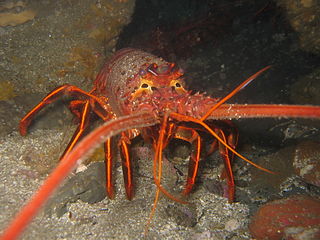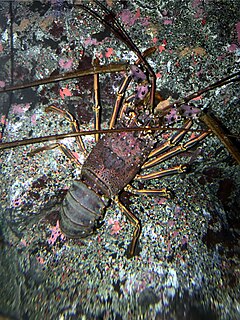
Spiny lobsters, also known as langustas, langouste, or rock lobsters, are a family (Palinuridae) of about 60 species of achelate crustaceans, in the Decapoda Reptantia. Spiny lobsters are also, especially in Australia, New Zealand, Ireland, South Africa, and the Bahamas, called crayfish, sea crayfish, or crawfish, terms which elsewhere are reserved for freshwater crayfish.

Homarus is a genus of lobsters, which include the common and commercially significant species Homarus americanus and Homarus gammarus. The Cape lobster, which was formerly in this genus as H. capensis, was moved in 1995 to the new genus Homarinus.

The California spiny lobster is a species of spiny lobster found in the eastern Pacific Ocean from Monterey Bay, California, to the Gulf of Tehuantepec, Mexico. It typically grows to a length of 30 cm (12 in) and is a reddish-brown color with stripes along the legs, and has a pair of enlarged antennae but no claws. The interrupted grooves across the tail are characteristic for the species.

Lobsters are widely fished around the world for their meat. They are often hard to catch in large numbers, but their large size can make them a profitable catch. Although the majority of the targeted species are tropical, the majority of the global catch is in temperate waters.

The Achelata is an infra-order of the decapod crustaceans, holding the spiny lobsters, slipper lobsters and their fossil relatives.

Slipper lobsters are a family (Scyllaridae) of about 90 species of achelate crustaceans, in the Decapoda clade Reptantia, found in all warm oceans and seas. They are not true lobsters, but are more closely related to spiny lobsters and furry lobsters. Slipper lobsters are instantly recognisable by their enlarged antennae, which project forward from the head as wide plates. All the species of slipper lobsters are edible, and some, such as the Moreton Bay bug and the Balmain bug are of commercial importance.

The Astacidea are a group of decapod crustaceans including lobsters, crayfish, and their close relatives.

Panulirus cygnus is a species of spiny lobster, found off the west coast of Australia. Panulirus cygnus is the basis of Australia's most valuable fishery, making up 20% of value of Australia's total fishing industry, and is identified as the western rock lobster.
Palibythus magnificus, sometimes called the musical furry lobster, is a species of furry lobster found in Polynesia. It is generally included in the family Palinuridae, although it has also been separated from that family with the genus Palinurellus to form the family Synaxidae in the past. The species is known in Samoan as ula moana, a name which also covers the deep-water shrimp Heterocarpus laevigatus.
Palinurus barbarae is a species of spiny lobster described in 2006, which was found by fishermen working the waters above the Walters Shoals, a series of submerged mountains 700 kilometres (430 mi) south of Madagascar. The animal weighs 4 kilograms (8.8 lb) and reaches up to 40 centimetres (16 in) long excluding the long antennae, and is similar to P. delagoae, found off South Africa, from which it may be differentiated by a number of characters including the larger number of spines. There are fears that the species, which lives in an area outside any country's jurisdiction, may now be exploited, or that it has already been brought near to extinction by overfishing.

The Japanese spiny lobster, Panulirus japonicus, is a member of the genus Panulirus of spiny lobsters. It grows up to 30 centimetres (12 in) long and lives in the Pacific Ocean around Japan, Taiwan, China, and Korea. P. japonicus is the subject of commercial lobster fishery in Japan. It is a popular item in high-class Japanese cuisine. Serving and preparation methods include sashimi, as a steak, frying, and roasting alive.

Palinurus elephas is a commonly caught species of spiny lobster from the East Atlantic Ocean and the Mediterranean Sea. Its common names include European spiny lobster, crayfish or cray, crawfish, common spiny lobster, Mediterranean lobster and red lobster.

Panulirus versicolor is a species of spiny lobster that lives in tropical reefs in the Indo-Pacific. Other names include painted rock lobster, common rock lobster, bamboo lobster, blue lobster, and blue spiny lobster. P. versicolor is one of the three most common varieties of spiny lobster in Sri Lanka, alongside Panulirus homarus and Panulirus ornatus.

Jasus is a genus of spiny lobsters which live in the oceans of the Southern Hemisphere. They have two distinct "horns" projecting from the front of the carapace, but lack the stridulating organs present in almost all other genera of spiny lobsters. Like all spiny lobsters, they lack claws, and have long stout antennae which are quite flexible.

Acanthacaris is a genus of deep-water lobsters. It contains two species, A. caeca and A. tenuimana, and is the only genus in the subfamily Neophoberinae.

Panulirus homarus is a species of spiny lobster that lives along the coasts of the Indian and Pacific Oceans. It lives in shallow water, and feeds on the brown mussel Perna perna. It typically grows to a length of 20–25 cm (7.9–9.8 in). Alongside the dark green nominate subspecies, two red subspecies are recognised, one around the Arabian Peninsula, and one around southern Africa. It is the subject of small-scale fishery.

Palinurus mauritanicus is a species of spiny lobster. It is found in deep waters in the eastern Atlantic Ocean and the western Mediterranean Sea.

Palinurus charlestoni is a species of spiny lobster which is endemic to the waters of Cape Verde. It grows to a total length of 50 cm (20 in) and can be distinguished from other Atlantic species in the genus by the pattern of horizontal bands on its legs. It was discovered by French fishermen in 1963, and has been the subject of small-scale fishery since. It is thought to be overexploited, and is listed as Near Threatened on the IUCN Red List.

The Sierra Madre Formation is a geologic formation in Chiapas state, southern Mexico. It consists of marine dolomites and limestones. The formation dates to the Middle Cretaceous, spanning from the Aptian of the Early to the Cenomanian of the Late Cretaceous.

Panulirus inflatus, the blue spiny lobster, is a species of crustacean in the family Palinuridae. It is found at rocky reefs to depths of 30 m (100 ft) in the Pacific Ocean off Mexico, ranging from Baja California to Chiapas. It is commonly caught in artisanal fisheries, but the species is not threatened, being categorized as least concern by the IUCN. There are no subspecies.

















